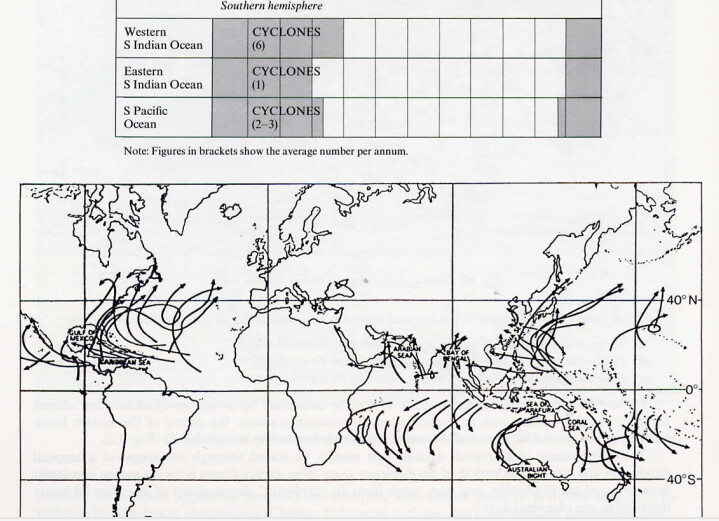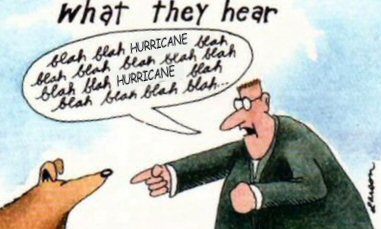Proves you wrong…
Not in the English language.
Don’t know if it mean something different in “Simplified English” (aka American English)
Here is something to help you find the difference:
Can we walk for starters through all stages of development , transition and track of hypothetical tropical compact revolving low pressure system. As I can see all agree, that to be assigned name “tropical” it must form and transit initialy in tropical zone /subtropical zone irrespective of longitude.
It seems to me all agree that upon reaching required wind speed in the vicinity of it’s center it will be called:
a) hurricane
b) typhoon (Taifun)
c) cyclone
Above a) b) c) are refered to as per the publication WMO as " “tropical cyclones” . Or alternative maritime term : " tropical revolving storm"
Before reaching the state and acquiring it’s geographical name a), b) ,c) it’s stages of development are as follows:
- tropical wave
- tropical wave disturbance
- tropical depression - organised and with defined max
wind speed - tropical storm- moderate to severe organised , with
defined max wind speed
Items 1,2,3,4 have common/same names irrespective of longitude/geography.
The moment item 4) reaches wind force B>12 at its core it acquires names a) or b) or c)
So now let’s assume my ship is navigating in close proximity of a system a) b) c) . Weather maps and printed weather reports will describe the system with geographical name( or it’s abbreviation) and provide other details. Irrespective if I am sailning in gale force winds , storm force winds or B> 12 i will say/describe this sailing condition as " i am navigating in a) b) or c) depending on my longitude/geographical location in tropical/subtropical zone.
Before i continue transit from tropical /subtropical zone to temperate zone I want to ask all a question :
Do You all agree with above? . If not pls comment .
10.12.24 late pm
From Global Guide to tropical cyclone forecasting
Have figured may be I can give the whole book to those weather buffs who kept this thread going as a gesture of appreciation.
More to come
I know English isn’t your first language and sometimes you struggle but you’ve even claimed two opposing positions throughout the discussion and didn’t even appear to realize you did.
You’ve claimed any weather system of force 12 or greater is a hurricane in Europe regardless of origin. You’ve been proven wrong on that point.
Any metrologist in Europe that calls a regular European wind storm of force 12 winds a hurricane is wrong, point blank.
Calling a weather system an Orkan is NOT the same as calling it a hurricane. The English word hurricane has a specific meaning that does not translate to most other languages that share the same word origin. Locals can use their local language to call the storms whatever they want, it doesn’t change what the word hurricane means in English.
Having read above and below I do confirm i do struggle.
Guess here is the source of all misunderstanding ![]()
How it is treated by our
The explanation as to the two meanings of ‘hurricane’, has to do with the history and development of Beaufort Scale.
From: Historical and Contemporary Versions of the Beaufort Scale
Pre-Beaufort here’s Daniel Defoe’s 1704 scale:
Last two rows of Beaufort’s Scale in 1806:

Beaufort’s 1831 version, first use of the term “Hurricane”

At that time meteorologist were not in agreement as to the nature of hurricanes, the idea that the systems were circular was considered an hypothesis.
William C. Redfield’s article on hurricane circulation
In the July 1831 edition of the American Journal of Science and Arts , William C. Redfield published an article in which he proposed that the winds of an 1821 hurricane were circular in nature. While others before him had proposed that such storms were large vortices, he presented evidence of tree falls after the 1821 storm which demonstrated the counterclockwise nature of the destructive winds. He also included observations from two other hurricanes in 1830 to further illustrate his hypothesis. He reconstructed the track of one of these 1830 storms and contended its path was driven by the prevailing winds. He also thought that hurricanes were generated when the Trade Winds interacted with the mountains of the Greater Antilles.
From the same source as your last, same subject (Name of phenomena):
And followed by:
Source: European windstorm - Wikipedia
Thank you for citing a source that disproves your claim.
Oh the standard “I know English isn’t your first language”
No it isn’t, but Standard English is the language I learnt in school and have used during most of my working life.
I have been able to understand and communicate with people who use different varieties of the English language, incl. Scottish, Geordies and Scouse from the UK, as well as a lot of “good ol’ boys for the Bayous” and 'round them parts.
I have also had to learn to communicate in “Tok pisin” at one time.
I realise that it is hard for you to accept that not everything American is universally correct, but you may as well get used to the fact that there are other ways of doing and saying things than what you are used to.
I claim the right to interpret the term “hurricane” different from than you, as does most of the world.
As has been demonstrated to you repeatedly, they don’t. You have yet to provide any source claiming otherwise.
As mariners we are not interested in how official weather terms are used colloquially. Our interest is the meaning of weather terms as used by the various weather organization.
The Beaufort Scale or Beaufort Wind Force Scale is a system for estimating wind strengths without the use of instruments, based on the effects wind has on the physical environment.
Here’s a Beaufort Wind scale that uses orkan:
If “orkan” is in fact used officially to mean any system with winds at F-12 or above it should be found defined that way in an official glossary or in a definition of terms used by that organization.
Good find
Both English, French and German terminology for the same thing; Bf. force 12 and above.
What causes the wind to reach Bf. force 12 and above, or where in the world it occurs is not an issue.
Here is the terms and signs used by the Norwegian forecasting service Yr.no:
Orkan ![]() 32,6- 64- Forekommer meget sjelden. Uvanlig store ødeleggelser.
32,6- 64- Forekommer meget sjelden. Uvanlig store ødeleggelser.
Source:
If you use Google translation on the above, “Orkan” becomes “Hurricane”.
Nothing said about where, from what and how it became an Orkan/Hurricane.
In other languages the term used for both tropical, ex-tropical and mid-latitude are the same, wherever it is in the world.
Although Typhoon is frequently used in newscasts and reports when TCs occure in the Asia-Pacific area.
In English language media Hurricane is used when reporting on a TC occure in the Caribbean, or in USA.
Can EVERYBODY now agree that we AGREES?
You keep on using Hurricane as the term for Tropical Cyclones and I can call them Taifun. The rest of the world can call them whatever they want.
Our forum friends in India, Australia and elsewhere south of Equator can call them just Cyclones.
PS> The Kiwis can call them whatever they want and enjoy their summer at the moment, while it lasts. Our turn will come “soon”. Then you can go skiing in Queenstown.
I don’t believe that I’ve done that, perhaps in error somewhere. I’m using the word as defined by the NWS and the WMO
Hurricane / Typhoon:
A tropical cyclone in which the maximum sustained surface wind (using the U.S. 1-
minute average) is 64 kt (74 mph or 119 km/hr) or more. The term hurricane is used for Northern Hemisphere tropical cyclones east of the International Dateline to the Greenwich Meridian. The term typhoon is used for Pacific tropical cyclones north of the Equator and west of the International Dateline. (NHC Glossary)
Ok Guys .
I am loosing it as I am not sure what is discussed here . Meteorology , marine meteorology , maritime meteorological terms, meteorological glossaries & terms and due to my limited knowlege of english I am completely unfit to discuss semantics with native speakers who are in majority .
So I will shut up and enjoy the circus by reading ![]()
The term hurricane is used for Northern Hemisphere tropical cyclones east of the International Dateline to the Greenwich Meridian.
I agree, as I have stated MANY times. No argument about that from my side.
TCs of Hurricane force seldom occurs on the African/European side of the Atlantic.
When one crosses the North Atlantic it becomes ex-tropical and usually are loosing force to below force 12 (not always)
I still don’t see where we disagree???
We are still skiing.
Would you agree, in the context here, being used in the Beaufort scale, that "Orkan means “hurricane-force”?
I certainly agree!! (As I have all along)
Hurricane/Ouragan/Orkan/(or similar in other European languages) referrer to sustained Wind Force 12 or above on the Beaufort Scale.
That doesn’t change if it is caused by a TC/TRS, or any other weather systems.
A different name may be used in any specific region, in any regional/local language.
As I have said; I prefer to call such phenomena Taifun (Typhoon in English).
If I happen to refer to a TC/TRS in the Bay of Bengal, Arabian Sea, Indian Ocean or the South Pacific I bow to the locals and call it a Cyclone.
Likewise, if I’m referring to a TC/TRS in the North Atlantic, or North East Pacific, I will use the term “Hurricane” to avoid misunderstandings, or confusing the locals.
Now, can we put this ridicules argument to rest. You have the power to do so, not me. Please do the needful ![]()











